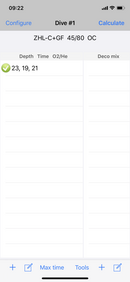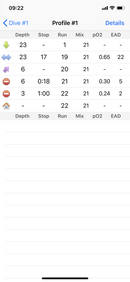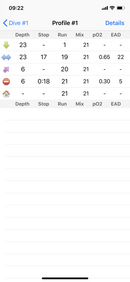Jeremy is right in that the a coefficients between the B and C Mo values are different, C being more conservative than B. The Mo (surfacing) values differ in the 5, 6, 7, 8, 9, 10, 11, 12, 14, and 15th tissue compartments. This suggests that profiles whose leading compartment is one of these will exhibit differences in deco and run times. The greater difference will probably be toward the slower compartments because they have the larger half-times compared with the faster compartments.
In regards to programming the same algorithm there are two other issues I can think of that will effect the outcome: rounding and the depth for descents and ascents. Consider this calculation: 2.388 x 4.268 = 10.1919. Rounding this result to 2 decimal places gives 10.19. If I do the rounding first I get 2.39 x 4.27 = 10.2053, truncating to two places gives 10.20, a difference of 0.01. 0.01 is not much but when working with bigger numbers or longer calculations with intermediate results the differences can be bigger, possibly affecting the profiles by minutes.
How to treat descents and ascents is an issue. In my spreadsheet I use the Schreiner equation to calculate each tissue compartment's inert gas load. The equation needs the inspired inert gas pressure at the current depth to calculate the tissue loading for that depth. But, which depth to use; The starting, median, or final depth? In the ss you can select which depth you want. Different computer programs may use different depths or some sophisticated calculation using the different types of depths.
Thanks, makes sense and I do agree about the rounding. I had the same issue with Subsurface and working out SACs. I eventually found a lonely FAQ or thread that mentioned how subsurface takes into account the something something of the cylinder and thats why it is different..
I have never used Baltic but multideco desktop and mobile does match my shearwater within about a minute.
Thanks for the confirmation, good to know. I had a test on this last Sunday on one of the dives and also established the same. Although not a perfect test as it was "just" into deco.
I spoke to Shearwater as to why MD and the Shearwater do not match exactly. They said in actual application due to ascent times, the numbers come out to be the same
Makes sense. Thanks for the addition. Not too worried about a minute here or there, but just the bigger gaps.
My two bar is this: I also did my 45 course with someone who used a different deco app than what I was using. We both had different deco times and runtime schedule was close but not the same. We both ran the dive, discussed the outcomes of each and made a decision as a team as to what we felt was the best.
We did not just throw a dart at one. Luckily we were both diving on Shearwater computers so we ran the same dives on the computers and with that info, we were able to make a more informed decision as to what we felt was the most appropriate ascent strategy for our team.
I say this because while the apps might be giving you different times, it is all about being a thinking diver and developing a plan using multiple tools that is the best for the team.
Good luck and let us know how the course goes for you.
Hey hey
Thanks
I would not lose sleep over a few minutes of differences. You did not say what you used for gradient factors and for example choosing those (which to some degree is guesswork) has a stronger influence on runtime than the differences you report. If I run a similar dive through Subsurface with reasonable GF's I get similar times as well:
View attachment 571951
Please note that even though different implementations each claim to be ZHL-16x, this algorithm is not specified to a precision that does not leave some room for interpretation. I blogged about this here: Why is Bühlmann not like Bühlmann – The Theoretical Diver
Thanks yeah. I am also not too worried about a minute or 2-3 here or there. But when the distance is greater, it can grow. Whats odd is as I mentioned before, that you add a deco gas and it basically reduces that down to 1min.
I also, having played now with multi deco a lot in the last 2 months have found a few bugs I feel. Some seem to not show again others show. Like the error mentioned before I think about the deco time being more than or greater. Yet there are 3 different numbers. And then when you delete all the gases/levels you are not using (even though they are unselected) it works?
Also this last weekend we could not get rid of a 1min stop at the last level by backing off the bottom time. Eventually over 10min of bottom time reduction and still nothing. i.e WELL within NDL limits, but still showed a deco stop. Eventually putting the last stop to 6m solved the added deco, but kept a minute at 6m still. So definitely still buggy software.
I work in that industry, so can understand bugs. But when its "life" "dependent" and for the money you pay for the app, I would maybe expect better? Unless it is just me or a random once off bug which is difficult to solve.
Any who...on to more dives and checking and lets see







